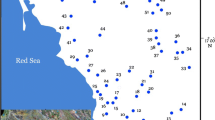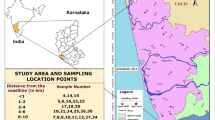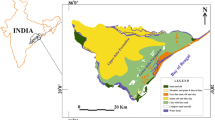Abstract
Seawater intrusion is a worldwide phenomenon resulting in groundwater quality challenges in coastal aquifers, which has prompted many investigations into its occurrence, sources, and age. To identify the origin of saline groundwater in the coastal communities of Central Region, Ghana, a combination of ten (10) different major ionic ratios—viz. Na/Cl, Mg/Cl, Ca/Mg, K/Cl, SO4/Cl, Ca/ (HCO3 + SO4), (Ca + Mg)/Cl, Cl/ (SO4 + HCO3), Na/Ca and Ca/SO4–and Base Exchange Index (BEX) computed from physico-chemical data on sixty-nine (69) boreholes in the communities have been analysed. The results show elevated levels of chloride concentrations in most of the groundwater in the study area, indicating salinization process by seawater intrusion. Also, the concentrations of the major ions (Na+, Ca2+, Mg2+, and SO42−) constituted more than 80% of the total dissolved solids and correlated well with Cl−, indicating they are from a common source. The spatial variation of the combined effect of the different ionic ratios and BEX classifications showed that, most of the groundwater with high salinity may be due to seawater intrusion. Significantly, the study has delineated areas in the communities with poor groundwater quality arising from seawater intrusion; these areas need to be avoided in the development of the resource for water supply.








Similar content being viewed by others
References
Abdalla F (2015) Ionic ratios as tracers to assess seawater intrusion and to identify salinity sources in Jazan coastal aquifer, Saudi Arabia. Arab J Geosci. https://doi.org/10.1007/s12517-015-2065-3
Abouchami W, Boher M, Michard A, Albarede F (1990) A Major 2. 1 Ga Event of Mafic Magmatism in West Africa’ An Early Stage of Crustal Accretion regions from the manfie that growth from of sinking mobile of the Ahaggar [Lancelot work by Boher data, 1990) have shown major series of orogenic episodes. J Geol Res 95:605–629
Adams O, Donkor P, Kankam S, Mensah J (2017) A Planners’ Guide to Integrated Coastal Management in the Central Region of Ghana. The USAID/Ghana Sustainable Fisheries Management Project (SFMP). Narragansett, RI. Coastal Resources Centre, Graduate School of Oceanography, University of Rhode Island; Spatial Solutions Limited, Accra; Hen Mpoano, Takoradi; and University of Ghana, Cape Coast, Ghana. GH 20 14 _ SC I037_SpS_HM_UCC. 65
American Public Health Association APHA (1995) Standard methods for the examination of water and wastewater, twentieth. American Public Health, Association (APHA), American Water Works Association (AWWA), and Water Pollution Control Federation (WPCF), New York, USA
Appelo CAJ, Postma D (2005) Geochemistry, groundwater and pollution, 2nd edn. A. A. Balkema Publishers, New York
Asiedu DK (2005) Provenance of late Ordovician to early Cretaceous sedimentary rocks from southern Ghana, as inferred from Nd isotopes and trace elements. J Afr Earth Sci 41:316–328. https://doi.org/10.1016/j.jafrearsci.2005.05.003
Bear J, Cheng AH, Sorek S, Ouazar D, Herrera I (1999) Seawater intrusion in coastal aquifers—concepts methods and practices. Springer-Science and Business Media, B.V
Capenter AB (1978) Origin and chemical evolution of brines in sedimentary basins. In: Thirteenth annual forum on the geology of industrail minerals. Michel TP-29 Perfector, 60–77
Carol ES, Kruse EE (2012) Journal of South American Earth Sciences Hydrochemical characterization of the water resources in the coastal environments of the outer Río de la Plata estuary, Argentina. J South Am Earth Sci 37:113–121. https://doi.org/10.1016/j.jsames.2012.02.009
Carol E, Kruse E, Mas-pla J (2009) Hydrochemical and isotopical evidence of ground water salinization processes on the coastal plain of Samborombón Bay, Argentina. J Hydrol 365:335–345. https://doi.org/10.1016/j.jhydrol.2008.11.041
Chang SW, Chung I, Kim M, Tolera M, Koh G (2019) Application of GALDIT in assessing the seawater. Water 11:1–17
Clark I (2015) Groundwater geochemistry and isotopes. CRC Press, Taylor & Francis Group, New York
Domenico PA, Schwartz WF (1997) Physical and chemical hydrogeology. John Wiley & Sons Inc, New York, USA
Douaoui A, Bradai A, Bennacer A, Fernández PM (2019) Application of kriging techniques for assessing the salinity of irrigated soils: the case of El Ghrous perimeter, Biskra. Spanish J Soil Sci 9:105–124. https://doi.org/10.3232/SJSS.2019.V9.N2.04
El Moujabber M, Samra BB, Darwish T, Atallah T (2006) Comparison of different indicators for groundwater contamination by seawater intrusion on the Lebanese Coast. Water Resour Manag 20:161–180. https://doi.org/10.1007/s11269-006-7376-4
Ganyaglo SY (2015) Hydrogeochemical and Isotopic Studies of Groundwater in Coastal Aquifers of Ghana: case study in the Central Region. PhD Thesis, University of Ghana.
Ganyaglo SY, Osae S, Akiti TT, Gibrilla A, Bam E (2010) Hydrogeochemical and isotopic studies of groundwater in the Central Region of Ghana. IAEA Symp Isot Hydrol 133:12665
Ganyaglo SY, Osae S, Akiti T, Armah T, Vitvar T, Ito M, Otoo IA, Ganyaglo SY, Osae S, Akiti T, Armah T (2017) Application of geochemical and stable isotopic tracers to investigate groundwater salinity in the Basin. Ochi-narkwa Hydrol Sci J 00:1–16. https://doi.org/10.1080/02626667.2017.1322207
Giménez E, Morell I (1997) Hydrogeochemical analysis of salinization processes in the coastal aquifer of Oropesa (Castellón, Spain). Environ Geol 29:118
Grenholm M (2011) Petrology of Birimian Granitoids in Southern Ghana: Petrography and Petrogenesis, Bachelor thesis, Department of Earth and Ecosystem Sciences, Division of Geology, Lund University
Hirdes W, Davis DW, Eisenlohr BN (1992) Reassessment of Proterozoic granitoid ages in Ghana on the basis of U/P b zircon and monazite dating. Precambrian Res 56:89–96
Jones BF, Vengosh A, Rosenthal E, Yechieli Y (1999) Geochemical investigation of groundwater quality. Seawater Intrusion in Coastal Aquifers-Concepts, Methods and Practices, Springer: Kluwer, The Netherlands, pp 51–71
Kazakis N, Pavlou A, Vargemezis G, Voudouris KS, Soulios G, Pliakas F, Tsokas G (2016) Seawater intrusion mapping using electrical resistivity tomography and hydrochemical data. An application in the coastal area of eastern Thermaikos Gulf. Greece Sci Total Environ 543:373–387. https://doi.org/10.1016/j.scitotenv.2015.11.041
Ketata-rokbani M, Gueddari M, Bouhlila R (2011) Use of geographical information system and water quality index to assess groundwater quality in El Khairat Deep Aquifer ( Enfidha, Tunisian Sahel ). Iran J Energy Environ 2:133–144
Kim J, Kim R, Koh D, Cheong T, Lee J (2003a) Application of cluster analysis for the hydrogeochemical factors of saline groundwater in Kimje. Korea Geosci J 7:313–322
Kim Y, Lee K, Koh D, Lee D, Lee S, Park W, Koh G, Woo N (2003b) Hydrogeochemical and isotopic evidence of groundwater salinization in a coastal aquifer : a case study in Jeju volcanic island. Korea J Hydrol 270:282–294
Kim R, Kim J, Ryu J, Koh D (2019) Hydrogeochemical characteristics of groundwater influenced by reclamation, seawater intrusion, and land use in the coastal area of Yeonggwang. Korea Geosci J 23:603–619
Klassen J, Allen DM (2017) Assessing the risk of saltwater intrusion in coastal aquifers. J Hydrol 551:730–745. https://doi.org/10.1016/j.jhydrol.2017.02.044
Klassen, J., Allen, D.M., Kirste, D., 2014. Chemical Indicators of Saltwater Intrusion for the Gulf Islands , British Columbia.
Kouzana L, Benassi R, Ben mammou A, Sfar felfoul M (2010) Geophysical and hydrochemical study of the seawater intrusion in Mediterranean semi arid zones. Case of the Korba coastal aquifer (Cap-Bon, Tunisia). J Afr Earth Sci 58:242–254. https://doi.org/10.1016/j.jafrearsci.2010.03.005
Lee J (2007) Groundwater chemistry and ionic ratios in a western coastal aquifer of Buan, Korea: implication for seawater intrusion. Geosci J 11:259–270
Leube A, Hirdes W, Mauer R, Kesse GO (1990a) The early proterozoic birimian supergroup of ghana and some aspects of its associated gold mineralization. Precambrian Res 46:139–165
Leube A, Hirdes W, Mauer R, Kesse GO, RohstoffeKesse GGO (1990b) The early proterozoic birimian supergroup of Ghana and some aspects of its associated gold mineralization. Precambrian Res 46:139–165
Louvat D, Luc J, Franc J (1999) Origin and residence time of salinity in the Aspo groundwater system. Appl Geochem 14:917–925
Machiwal D, Jha MK, Mal BC (2011) Assessment of groundwater potential in a semi-arid region of india using remote sensing, GIS and MCDM techniques. Water Resour Manag. https://doi.org/10.1007/s11269-010-9749-y
Marimuthu S, Reynolds DA, Gal CL, Salle L (2005) A field study of hydraulic, geochemical and stable isotope relationships in a coastal wetlands system. J Hydrol 315:93–116. https://doi.org/10.1016/j.jhydrol.2005.03.041
Martínez J, Benavente J, García-Aróstegui JL, Hidalgo MC, Rey J (2009) Contribution of electrical resistivity tomography to the study of detrital aquifers affected by seawater intrusion-extrusion effects: the river Vélez delta (Vélez-Málaga, southern Spain). Eng Geol 108:161–168. https://doi.org/10.1016/j.enggeo.2009.07.004
Mercado A (1986) The use of hydrgeochemical patterns in carbonate sand and sandstone aquifers to identify intrusion and flushing of saline water. Ground Water 23:635–645
Mtoni Y, Chikira ICM, Bakundukize C, Van Camp M, Martens K, Walraevens K (2013) Saltwater intrusion and nitrate pollution in the coastal aquifer of Dar es Salaam Tanzania. Environ Earth 70:1091–1111. https://doi.org/10.1007/s12665-012-2197-7
Nadler A, Magaritz M, Mazor E (1980) Chemical reactions of seawater with rocks and freshwater: experimental and field observations on brackish waters in Israel. Geochim Cosmochim Acta 44:879–886
Nadler A, Koyumdjisky H, Dan J (1981) The use of Na/Cl ratios to trace solute sources in a semiarid zone. Water Resour Res 17:602–608
Nair IS (2016) Assessment of seawater intrusion in an alluvial aquifer by hydrochemical-isotopic signatures and geochemical modelling, PhD thesis, Faculty of Science and Humanities, Anna University
Panno SV, Hackley KC, Hwang HH, Greenberg SE, Krapac IG, Landsberger S, Kelly DJO (2006) Characterization and identification of Na–Cl sources in ground water. Ground Water 44:176–187. https://doi.org/10.1111/j.1745-6584.2005.00127.x
Pradhan B (2014) Groundwater potential zonation for basaltic watersheds using satellite remote sensing data and GIS techniques Groundwater potential zonation for basaltic watersheds using satellite remote sensing data and GIS techniques. Cent Eur J Geosci Groundw. https://doi.org/10.2478/v10085-009-0008-5
Rao YS, Jugran DK, Rao YS (2016) Delineation of groundwater potential zones and zones of groundwater quality suitable for domestic purposes using remote sensing and GIS. Hydrol Sci J 6667:821–833. https://doi.org/10.1623/hysj.48.5.821.51452
Rosenthal E (1988) Hydrochemical changes induced by overexploitation of groundwater at common outlets of the Bet Shean-Harod multiple-aquifer system Israel. J Hydrol 97:107–128
Scheidleder A (2003) Indicator fact sheet (WQ03b) saltwater intrusion. European Environment Agency. http://www.eea.europa.eu/dataandmaps/indicators/saltwater-intrusion/saltwater-intrusion. Accessed 20 Feb 2020
Serele C, Perez-hoyos A, Kayitakire F (2019) Geoscience Frontiers Mapping of groundwater potential zones in the drought-prone areas of south Madagascar using geospatial techniques. Geosci Front. https://doi.org/10.1016/j.gsf.2019.11.012
Ghana Statistical Service (2013) 2010 Population and housing Census: regional analystical report. Central Region
Schoeller H (1956) Geochemie des eaux souterraines.Application aux eaux des gisements de petrole, Soc. Ed. Technip, Paris, pp 213
Siedu DKA, Ampare SBD, Akyi PASS, Akubo BBA, Sae SO (2004) Geochemistry of Paleoproterozoic metasedimentary rocks from the Birim diamondiferous field, southern Ghana: implications for provenance and crustal evolution at the Archean-Proterozoic boundary. Geochem J 38:215–228
Stoessell RK (1997) Delineating the chemical compoition of salinity sources for saline water: an example from east-central Concordia parish, Louisiana. Ground Water 35:409–417
Stuyfzand PJ (1989) A new hydrochemical classification of water types. In: Regional characterization of water quality. The Netherlands Waterworks Testing and Research Institute KIWA, BB Nieuwegein, The Netherlands, pp 89–98
Stuyfzand PJ (1993) Hydrochemistry and hydrology of the coastal dune area of the Western Netherlands, PhD, Vrije Universiteit Amsterdam
Stuyfzand PJ (2008) Base exchange indices as indicators of salinization or freshening of (coastal) aquifers. In: 20th salt water intrusion meeting. Naples, Florida, USA, pp 262–265
SudaryantoNaily W (2018) Ratio of major ions in groundwater to determine saltwater intrusion in coastal areas. Earth Environ Sci 118:5
Todd DK (1959) Ground water hydrology. United States. John Wiley and Sons. Inc. pp 277–294
Todd DK, Mays LW (2005) Groundwater Hydrology, 3rd edn. John Wiley & Sons Inc, United States of America
Vengosh A, Pankratov I (1998) Cloride/bromide and chloride/flouride ratios of domestic sewage effluents and associated contaminated groundwater. Ground Water 36:815–825
Vengosh A, Rosenthal E (1994) Saline groundwater in Israel: its bearing on the water crisis in the Country. J Hydrol 1694:389–430
Zarei M, Raeisi E, Merkel BJ (2012) Identifying sources of salinization using hydrochemical and isotopic techniques Konarsiah, Iran. Environ Earth Sci. https://doi.org/10.1007/s12665-012-2143-8
Funding
The authors have no relevant financial or non-financial interests to disclose.
Author information
Authors and Affiliations
Corresponding author
Ethics declarations
Conflict of interest
The authors have no conflicts of interest to declare that are relevant to the content of this article.
Additional information
Publisher's Note
Springer Nature remains neutral with regard to jurisdictional claims in published maps and institutional affiliations.
Rights and permissions
About this article
Cite this article
Asare, A., Appiah-Adjei, E.K., Ali, B. et al. Assessment of seawater intrusion using ionic ratios: the case of coastal communities along the Central Region of Ghana. Environ Earth Sci 80, 307 (2021). https://doi.org/10.1007/s12665-021-09601-x
Received:
Accepted:
Published:
DOI: https://doi.org/10.1007/s12665-021-09601-x




